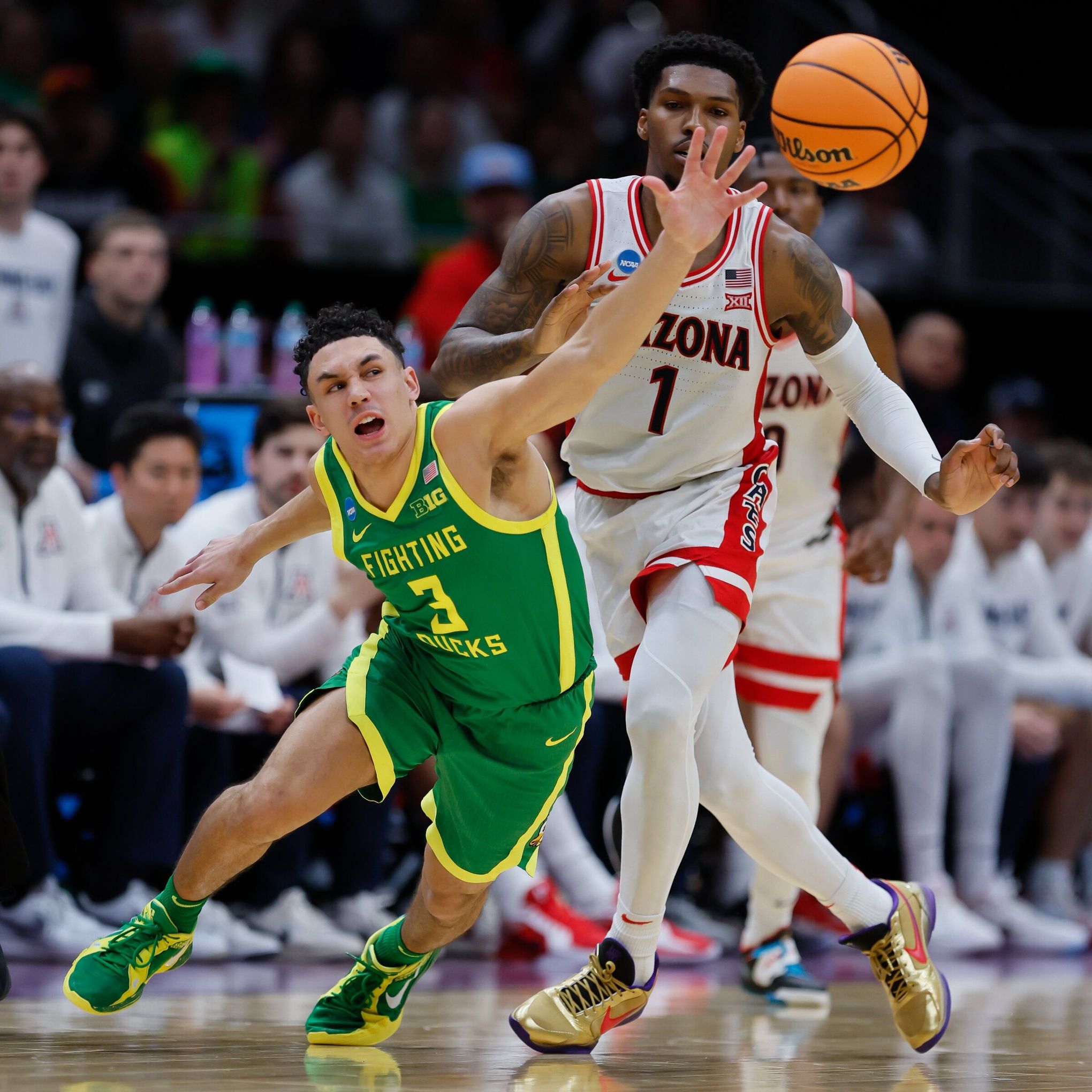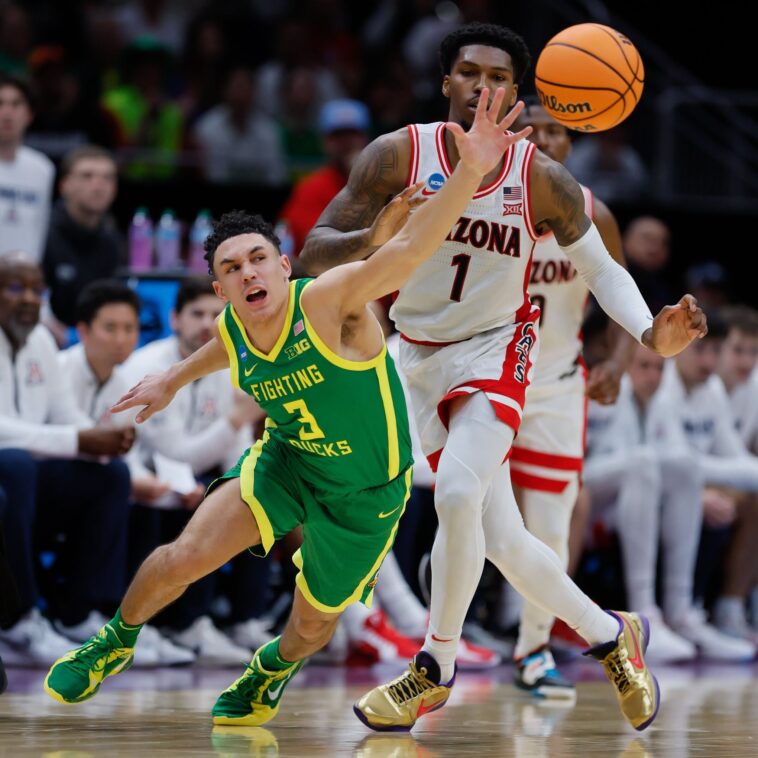
Arizona vs. Oregon: A Closer Look at the NCAA Tournament Clash
The 2025 men’s NCAA Tournament is well underway, and as the second round unfolds, college basketball enthusiasts find themselves in for a nerve-racking experience. In today’s matchup, the Arizona Wildcats take on the Oregon Ducks—a meeting that pits two former Pac-12 rivals against each other with seeding and team performance in mind. Both squads have demonstrated talent, determination, and strategic play, creating a game filled with intriguing match-ups and plenty of talking points. This opinion editorial will explore what to expect from the encounter, highlighting defensive tactics, offensive schemes, and the overall atmosphere surrounding the game. We will also take a closer look at team rankings, coaching approaches, and future implications for each program.
With an emphasis on balancing statistics and intuition, this piece will analyze the opinions of various sports commentators and experts. Our aim is to offer readers a nuanced view of the game by discussing key points that might otherwise be overlooked by casual fans. In doing so, we hope to clarify some of the trickier parts of tournament analysis, offering insight into the various twists and turns that can shape the outcome of such high-stakes contests.
Team Overview: Arizona Wildcats and Oregon Ducks
The Arizona Wildcats entered the tournament as a No. 4 seed after defeating Akron in a compelling opening-round performance. Known for their tenacity and a lineup that prefers to attack the basket, the Wildcats have quickly turned heads with their dynamic offense and robust defensive strategies. Despite a season filled with a few tangled issues such as injuries and inconsistent play during the early rounds, Arizona has shown resilience and adaptability, which serves them well in the high-pressure environment of March Madness.
In contrast, the Oregon Ducks, seeded fifth after toppling Liberty, have made a mark with their distinct style of play. The Ducks are recognized for their well-rounded approach—they boast a disciplined defense and an offense that can quickly transition from half-court sets to fast-break opportunities. Oregon’s journey to the second round has been fueled by tactical adjustments and mitigating some of the confusing bits that have dogged their play this season. With both teams coming from the same conference lineage, the familiarity in style and historical rivalry add an extra layer of excitement to this matchup.
Understanding the Tournament Brackets: The Role of Seeding and Rankings
One of the key focal points in understanding this game is the seeding. Arizona, with a No. 4 seed, is expected to have a slight edge over the fifth-seeded Oregon Ducks. The seeding, however, only provides part of the picture, as it reflects the entirety of a team’s performance over the season. Arizona ranks as the 12th-best team in the KenPom rankings, demonstrating a balanced approach with the 13th-best offense and the 24th-best defense. These figures indicate their ability to score efficiently while also contending with the tougher parts of guarding opponents.
Conversely, Oregon’s KenPom position at 28 overall, paired with a 35th-ranked offense and a 22nd-rated defense, suggests that while they might occasionally face challenges on the scoring front, their defensive setup has proven to be competitive. These statistics, full of subtle details, give us a glimpse into the fine shades of team performance in a tournament where every possession matters.
The seeding and rankings serve as a starting point, but they only begin to scratch the surface of the game’s real dynamics. Fans and analysts alike must take into account the little details: the coaching decisions, the adjustments made on the fly, and the influence of key players who can single-handedly change the course of the match.
Key Players to Watch in This Intense Championship Encounter
Critical to the outcome of this clash will be the star athletes on both teams. For the Wildcats, their standout guard has been a beacon of hope during the tournament. His ability to get into the paint, distribute the ball, and take crucial three-pointers makes him one of the player’s super important assets as Arizona navigates through the tangled issues inherent in tournament play.
On the other side, the Ducks have a forward whose performance in recent games has been nothing short of impressive. His quick reflexes on defense and his knack for scoring in tight situations underline why he is considered the key to Oregon’s chances. With both teams boasting players capable of changing the narrative in a matter of seconds, the head-to-head competition is set to be a showcase of talent and tactical shifts, where even the smallest twist and turn in play can lead to big momentum shifts.
In addition, bench players and role players might also step up to fill gaps during off-peak moments. This is where the unheralded details—the little nuances that often fly under the radar—can ignite a game. Whether it’s a timely steal, a critical rebound, or a well-executed assist, these contributions make the game far more unpredictable and exciting to watch.
Coaching Strategies: Breaking Down Game Plans and Tactical Approaches
At the heart of this game are the coaching strategies that both teams employ. Coaches on both sides are tasked with not just preparing their teams for opponents but also for the unexpected developments that come with high-pressure tournament play. Arizona’s coaching staff has placed strong emphasis on aggressive offensive sets and disciplined defensive rotations. Their approach involves quickly figuring a path through the opponent’s setup, maximizing scoring chances, and minimizing turnovers.
Meanwhile, Oregon’s coaching crew is known for working through the subtle parts of their game plan—teaching players to be adaptable in the face of new challenges. Their tactical adjustments during timeout and game break moments often involve modifying zone defenses, speeding up the transition, or even isolating key match-ups. This game plan management is all about finding the balance between structured play and creative improvisation, making every minute on the court a live, unfolding strategy session.
Coaches will also pay close attention to the opposing team’s set plays, probing for ways to disrupt and trigger turnovers. Given the unpredictable nature of March Madness, every decision by the bench or head coach can swing momentum. When teams are dealing with intimidating or overwhelming game situations, a coach’s experience and ability to steer through complicated pieces of strategy may be the decisive factor.
Comparative Analysis: Offensive and Defensive Match-ups
When it comes to offense, Arizona’s Wildcats are renowned for their balanced attack. With a 13th-best offense ranking according to KenPom, they combine fast breaks with half-court precision. Their offensive tactics rely extensively on utilizing the spacing of the floor, ball movement, and tapping into the hidden complexities of team chemistry. Their ability to handle the ball and run creative plays is often a decisive element, especially when the clock winds down.
The Ducks, although recognized for their defense, face a significant challenge with a 35th-ranked offensive rating. This might initially appear as a disadvantage; however, Oregon’s method of running set plays and capitalizing on transition opportunities could offset those difficulties. Ultimately, this game will be a clash of contrasting styles—Arizona’s aggressive scoring against Oregon’s methodical and robust defensive work.
To make this comparison clearer, consider the following table that summarizes key team statistics:
| Team | KenPom Overall Rank | Offensive Rank | Defensive Rank | Seed |
|---|---|---|---|---|
| Arizona Wildcats | 12 | 13 | 24 | 4 |
| Oregon Ducks | 28 | 35 | 22 | 5 |
This table outlines the essential figures behind each team’s performance. The comparative view reinforces how a disparity in offensive efficiency might balance against a solid defensive scheme, setting the stage for a matchup where every possession could ultimately decide the fate of the game.
Statistical Trends and Historical Insights: Lessons from Past Tournaments
History often serves as a guide in the realm of college basketball, and March Madness is known for its unpredictable outcomes. In past tournaments, teams seeded similarly to Arizona and Oregon have delivered performances that contradicted conventional wisdom. The key takeaway is that rankings, while illuminating, do not always tell the full story.
In many instances, the team with a lower seed has managed to outmaneuver a top seed by exploiting the little twists in the opponent’s game plan. Historical trends suggest that momentum shifts, often triggered by a series of consecutive plays, can have a lasting impact on the overall game dynamics. The Ducks, with their resilient defensive line, have sometimes found ways to counteract a superior offensive team by focusing on every possession and keeping the game close.
- Past performance in close games: Often, team mentality plays an undervalued role in the final outcome.
- Critical momentum shifts: A couple of consecutive stops or turnovers can redefine the game’s flow.
- Impact of bench contributions: The role players can be the unsung heroes when the stage is set for an upset.
By combing through the fine points of historical data and previous tournament trends, analysts can sometimes anticipate the likely direction of the game. However, as with any sporting event, external factors like officiating, crowd energy, and individual player moments add layers of unpredictable tension, making the outcome anything but guaranteed.
Expert Predictions and Consensus: Weighing In on the Outcome
In the run-up to the game, experts have offered a mix of opinions on who holds the advantage. Some commentators lean toward Arizona due to their slightly superior seeding and offensive prowess, while others argue that Oregon’s structured defensive play might provide enough resistance to offset their scoring challenges. The split in opinions reflects the inherent uncertainty in nearly every basketball contest, where the momentum of one or two plays can alter the dynamics completely.
The following bullet list summarizes the predictions from some leading voices in college basketball analysis:
- Jordan Mendoza: Picks Arizona to leverage their offensive consistency.
- Paul Myerberg: Favors Arizona, citing their edge in tournament experience.
- Erick Smith: Believes Arizona’s balanced attack will outpace the Ducks.
- Eddie Timanus: Finds Oregon’s defensive adaptability as key to turning the tide.
- Dan Wolken: Suggests that tough defensive assignments could give Oregon an edge.
- Jeremy Cluff: Predicts a tightly contested game, with a close scoreline favoring Arizona, 79-75.
Although predictions are valuable for gauging public sentiment, they do not always capture the spontaneous adjustments made by coaches mid-game. In these nerve-racking moments, the decision-makers on the sidelines often have to figure a path through complex sequences of plays, making real-time strategy as important as any pre-tournament statistic.
Game Day Atmosphere: The Venue, Timing, and Fan Energy
The game is set to take place at Climate Pledge Arena in Seattle, an environment known for its electric atmosphere and passionate fan base. The venue itself adds another layer of excitement and energy, contributing to an experience that transcends the typical regular-season match-up. Seattle’s arena, with its modern facilities and excellent acoustics, offers a stage where the echoes of historic tournaments can be felt, and where the collective roar of eleven-thousand-plus fans can spur teams to elevate their play.
The pre-game buildup is filled with countless discussions about how arena energy influences performance. For players stepping onto a court where every seat exudes enthusiasm or pressure, the ambiance can be both uplifting and overwhelming. Whether it’s the support for a hometown hero or the anxiety of performing under intense scrutiny, these moments remind us why March Madness is revered as one of college basketball’s most flavorful experiences.
The specific game time—8:40 p.m. ET (5:40 p.m. PT) on Sunday, March 23—means that teams will be under the glare of prime-time pressures as well, both from critics and from supporters expecting a standout performance. The convergence of these factors creates a setting where even the smallest detail, be it a call by the referee or a timely timeout, can steer the final outcome.
Key Aspects: A Deeper Dive into Offensive and Defensive Performance
Looking further into the strategies that have defined both teams’ journeys to this match, offensive schemes and defensive fortitude emerge as the crucial elements. Arizona’s offensive approach is known for its fluidity in ball movement and its reliance on quick passes that create open looks. This method not only provides an exciting style of play but also forces the opposition to adjust swiftly, sometimes resulting in turnovers.
Oregon, conversely, takes pride in its methodical, almost surgical, defensive strategies. Their focus on switching and help defense has allowed them to neutralize opposing scoring threats time and time again. This careful attention to the small distinctions that separate a good defense from an exceptional one might just serve as the tipping point in this matchup.
In tactical terms, both teams appear to be prepared to exploit the opposing team’s weaker areas. For instance, Arizona might look to leverage space along the perimeter to create driving lanes, while Oregon could work on stifling the Wildcats’ outside shooting with tight, pressure-packed coverage. By taking a closer look at these subtle parts, we begin to understand that the true beauty of this game lies in how minor adjustments can have major effects on the final outcome.
Here’s a bullet list that summarizes some of the key factors to watch during the game:
- Turnover rates: Who handles the ball better under pressure?
- Rebound disparity: Which team can control the boards and dictate the pace?
- Defensive adjustments: How do coaches adapt to the opposing team’s tactics?
- Three-point shooting efficiency: Can one team out-pace the other in long-range scoring?
- Bench contributions: Do the role players step up during critical junctures?
Each of these aspects embodies the small yet critical decisions that can affect the game’s rhythm—whether it’s the Ducks’ ability to disrupt a fast break or the Wildcats’ knack for capitalizing on a defensive lapse. The match-up promises to test the teams’ ability to both make smart decisions and adjust on the fly.
Predicting the Outcome: An Equilibrium of Stats and Instinct
Predicting the outcome of an NCAA Tournament game is always a balancing act. Statistically, Arizona’s slight edge in seed and offensive efficiency suggests that they have the upper hand; however, Oregon’s disciplined defensive approach cannot be overlooked. This equilibrium between numbers and on-court execution creates an environment where one mistake can flip the script entirely.
The betting odds as of the game day provide further insight into how public perception weighs in. With Arizona favored by a spread of -3.5, a moneyline of -175, while Oregon sits as the underdog at +145 and the total set at 151.5, the betting markets hint at a competitive yet slightly lopsided contest. These odds indicate that while the Wildcats are expected to pull ahead, the margin could be slim—a scenario that bodes well for fans looking for a nail-biting finish.
The game’s close predicted score, such as Jeremy Cluff’s projection of a 79-75 victory for Arizona, underscores how every minor play might contribute to the final tally. When teams are neck-and-neck, the stuff that might seem trivial in regular season play—like a defensive stop or a critical timeout—can take on a super important role in determining the winner.
Long-Term Implications: What This Game Means for the Tournament Journey
The outcome of this game will have lasting effects on both teams’ tournament runs. For the Wildcats, a win would affirm their status as a serious contender for the national championship, reinforcing the confidence needed to take on even more intimidating challenges in the later rounds. Their balanced scoring and steady defense would be viewed as must-have assets in tournament lore.
Oregon, meanwhile, would be earning extra credibility if they manage to upset expectations and break through the barrier presented by Arizona. A strong performance from the Ducks could trigger a momentum shift that empowers them for future games, particularly if their defensive setups can continue to reel off stops and force turnovers. Even in defeat, a competitive effort against a highly-seeded opponent might serve as valuable experience for the program’s development.
This game is not just another stop along the road to the Final Four; it is also a litmus test for the teams’ overall ability to work through tricky parts in tournament play. Success here will require making precise adjustments and keeping composure when the pressure feels overwhelming—a quality that separates contenders from pretenders in college basketball.
From an institutional perspective, a win for either team brings additional attention and opportunities. Increased media coverage, enhanced recruitment prospects, and the building of a lasting legacy in their respective conferences are all potential long-term benefits. Moreover, the win could help set the tone for a program’s culture, encouraging not just skillful play but also strategic thinking and teamwork at every level.
Breaking Down the Expert Consensus: A Graphical View of Predictions
To provide a clearer picture of the overall expert sentiment, the following table encapsulates key predictions and scores put forward by several analysts. This snapshot offers readers a graphical representation of the diverse points of view surrounding this matchup:
| Expert | Prediction | Key Rationale |
|---|---|---|
| Jordan Mendoza | Arizona Wins | Offensive consistency, superior seeding |
| Paul Myerberg | Arizona Wins | Experience in high-pressure settings |
| Erick Smith | Arizona Wins | Balanced attack with strong perimeter play |
| Eddie Timanus | Oregon Upsets | Defensive adaptability to disrupt game flow |
| Dan Wolken | Oregon Wins | Tactical assignments in key moments |
| Jeremy Cluff | Arizona Wins (79-75) | Close contest with marginal margin |
This variety of opinions reflects the unpredictable nature of tournament basketball. The head-to-head encounter between Arizona and Oregon will undoubtedly be colored by the way in which both teams handle the unexpected, from a sudden shift in momentum to a momentary lapse in concentration.
Off-Court Factors: The Impact of Media, Fan Culture, and Institutional Legacy
Beyond the boundaries of the basketball court, several off-court issues contribute to the overall narrative of this game. Media coverage, for instance, plays a critical role in shaping the public’s perception of each team. The extent to which a team’s story is highlighted can enhance the collective pressure or, conversely, provide a supportive boost that galvanizes players on the floor.
Fan culture in college basketball is unique, measured not just by the fervor of the supporters but also by how traditions and historical legacies shape expectations. At Climate Pledge Arena, the blend of modern facilities and an electric atmosphere gives fans a platform to express both celebration and critique. These extended narratives often become part of the institutional legacy each program builds over multiple seasons.
Additionally, college sports often carry an identity that extends into academic and community pride. A successful tournament run feeds into this narrative, establishing a legacy that endures well beyond the final buzzer. For players on both teams, performing in the spotlight is not just about individual accolades but also about contributing to the long-term reputation of their programs.
The interplay between on-court performance and off-court support exemplifies how a game is influenced by a blend of tangible facts and swirling cultural forces. In moments when the score is tight and pressure looms large, fans and the media become part of a larger story—one that is woven through every pass, every block, and every buzzer-beater. The lively interaction between these external factors and the intrinsic dynamics of the game often results in a narrative that is as memorable as any championship game in NCAA history.
Strategies for Success: How Coaches and Players Counteract Nerve-Racking Moments
One of the defining features of tournament basketball is the ability of coaches and players to respond to nerve-racking circumstances. Both teams are expected to encounter moments where the situation can feel overwhelming—whether it’s an unexpected turnover, a surge in the opponent’s momentum, or a string of missed opportunities. In these scenarios, the leadership on the bench is tested to its limits.
Arizona’s coaching staff is known for their proactive measures. They frequently design quick timeout rotations that not only highlight the fine points of defensive adjustments but also refocus the team’s energy. The process involves quickly gathering the players, discussing which adjustments need to be made, and then getting right back into the fray with renewed determination.
Oregon’s approach, on the other hand, relies on an ingrained sense of composure and methodical play calls. By emphasizing communication on the court and encouraging players to trust each other in critical moments, the Ducks have built a foundation that allows them to stay calm amid the storm. This focus on teamwork and adaptability ensures they remain resilient even when the game takes unexpected turns.
Both teams recognize that during moments of high pressure, every player’s contribution becomes extra important. Whether it’s a timely basket from the bench or a crucial defensive stop, these acts can sometimes be the difference between victory and defeat. The ability to work through confusing bits and find a path forward is what distinguishes a great team from a good one.
Conclusion: Anticipating a Battle of Determination and Strategy
As the second-round action of the 2025 NCAA Tournament approaches, the face-off between the Arizona Wildcats and the Oregon Ducks promises to be a captivating contest. Both teams enter the fray with distinct identities—Arizona possessing a razor-sharp offensive edge and Oregon boasting a sturdy, disciplined defensive framework. With closely matched seeding and a host of intricate factors at play, the game is set to be decided by both the well-prepared coaching strategies and the determination of key players on the floor.
This matchup is more than just a routine elimination game—it is an embodiment of the spirit of March Madness. In every pass, every strategic call, and every cheer from the crowd, we see a testament to the passion and complexity of college basketball. Fans and analysts alike will be watching with baited breath as these teams take the wheel, managing their way through challenging moments and turning every possession into a potential game-changer.
As we look forward to a second-round showdown filled with tense moments, off-court narratives, and a palpable sense of urgency, one thing remains clear: in the tangled issues of tournament play, every second counts. Whether it’s Arizona’s balanced approach or Oregon’s resilient defense, the outcome will hinge on which team can best combine statistics with on-the-spot intuition.
In the grand scheme of college basketball, games like these serve as a reminder of the sport’s unpredictability and the beauty of competition. Fans have the opportunity not only to enjoy spectacular displays of athletic prowess but also to witness firsthand how strategy, heart, and a touch of serendipity can shape the legacy of a tournament season.
With the clock ticking down and expectations running high, the impending clash at Climate Pledge Arena is set to deliver an experience that will be remembered for its intensity, strategic brilliance, and the raw emotion of March Madness. As both teams prepare to face one of the trickiest parts of tournament play—a battle where every dribble, every shot, and every decision is magnified—the stage is set for a contest that captures the very essence of college basketball.
Ultimately, the game between Arizona and Oregon is not just about which team emerges victorious; it is about celebrating the enduring spirit of competition, the art of coaching, and the collective effort that defines NCAA Tournament basketball. Fans will be treated to a night where the scores reflect more than just numbers—they tell a story of resilience, teamwork, and the relentless pursuit of excellence. As we await tip-off, the outcome remains uncertain, but one thing is assured: this encounter embodies the very best of what college sports has to offer.
Originally Post From https://www.usatoday.com/story/sports/ncaab/2025/03/23/arizona-oregon-prediction-odds-ncaa-bracket/82626813007/
Read more about this topic at
Expert reveals his TOP NCAA Tournament teams at EACH …
Three NCAA Tournament teams that DON’T match their …


